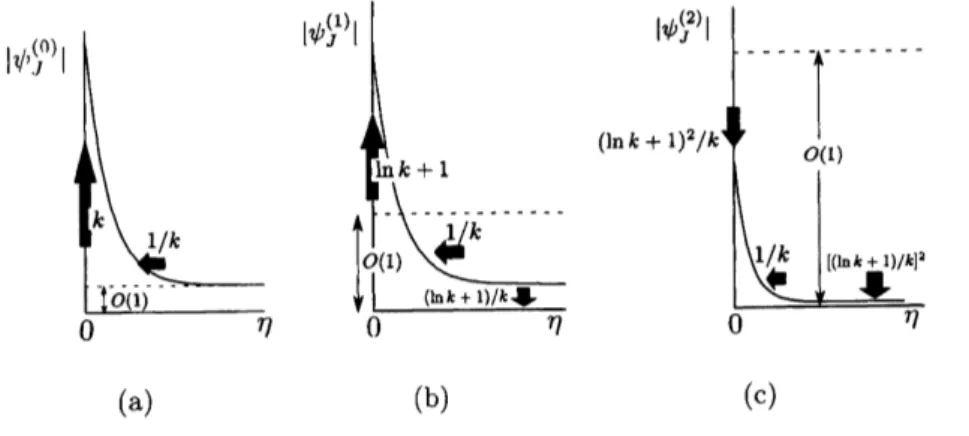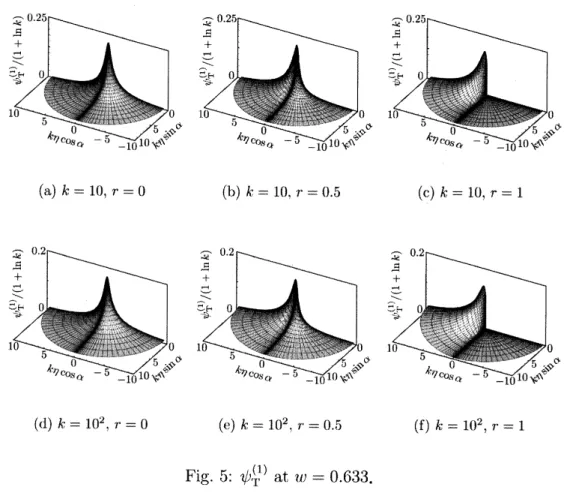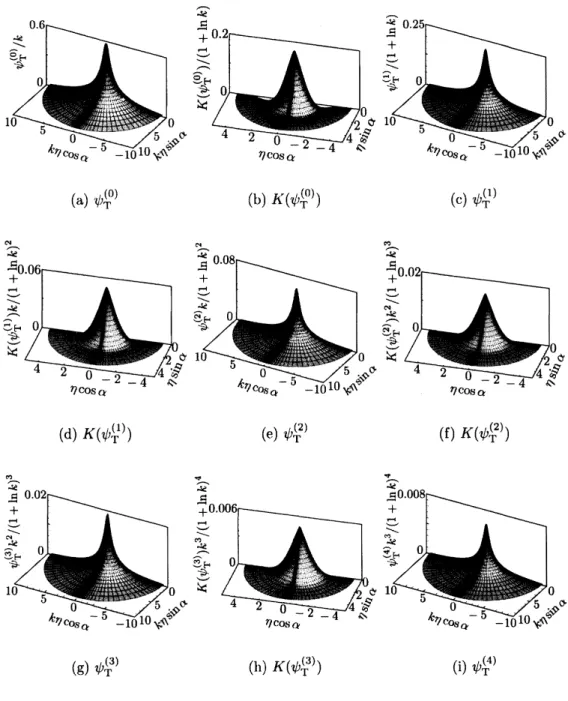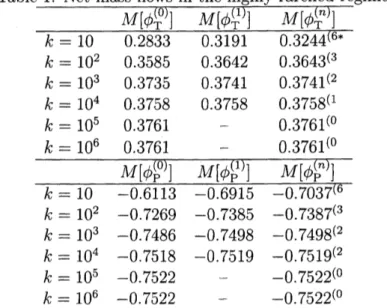lDepartment
of Mechanical Engineering and Science, Kyoto University, Kyoto 606-8501, Japan2Advanced
Research Institute of Fluid Science and Engineering,Kyoto University, Kyoto 606-8501, Japan
Abstract
Hagen-Poiseuille and
thermal
transpiration flows ofa
highly rarefiedgas
througha
long circular pipe
are
investigatedon
the basis of the linearized Boltzmann equation forhard-spheremolecules withthediffuse reflection condition. Thenet
mass
flowsofthebothproblems in the highlyrarefied regime
are
obtained byan
iterative approximationmethodwith
an
explicit convergence estimate. The singular behavior of the velocity distributionfunctions in that regime is also clarified.
1
Introduction
A flowinduced by
a
pressuregradient (Poiseuille flow) anda
flow inducedbya
temperaturegradient (thermaltranspiration, see, e.g., Ref. [9]) are classical andfundamental problems
of
rarefied gas
dynamics, and have beenextensivelystudied by many researchers (see,e.g.,
Refs.
[1,3, 5-9] and thereferences
therein).In the present study,
we
shall focus on Hagen-Poiseuille and thermal transpirationflows of a highly rarefied gas through
a
circular pipe, for the purpose of obtaining theaccurate data of the net
mass
flows. In the highly rarefied regime,an
accurate analysisof these flows
on
the basis of the (linearized) Boltzmann equation isa
hard task becauseofthe singular behavior ofthe velocity distribution functions, in addition to the complex
collision operator of the equation. In order to
overcome
these difficulties,we use an
iterative approximation method with
an
explicitconvergenceestimate, whichwas
recentlydeveloped by the authors in Ref. [11] withthe aid ofthe mathematical estimates givenby
Chen et al. [2]. Main advantage of this method is that we can start the iterative process
from
an
initial guess withan
explicit form that contains the majority of the singularityin the velocity distribution functions. Moreover, the method gives an estimate
on
therequired numberof iterations to obtain the practical convergedsolution and the behavior
ofthe velocity distribution function at each stage of iteration.
Thepaperisorganized
as
follows. Insection 2,we
formulatethe problems. In section 3,we
presentan
iterative approximation method and its explicitconvergence
estimate ateach stage of iteration in the highly rarefied regime. Also,
we
clarify the behavior ofthe velocity distribution functions by using the estimate. In section 4,
we
present thenumerical methods based
on
the iterative approximation method. Numerical resultsare
2
Problem
and
formulation
Consider a highly rarefied gas in a long pipe with a uniform circular
cross
section. Letthe radius of the pipe be $D$ and the $X_{3}$ axis be parallel to the pipe. The pressure of
the gas is given by $p_{0}(1+c_{P}X_{3}/D)$ and the temperature of the pipe wall is given by
$T_{0}(1+c_{T}X_{3}/D)$ ($c_{P}$ and $c_{T}$ are constants). We investigate the steady gas flows under the
followingassumptions: (i) the behavior ofthe gasisdescribed by the Boltzmannequation
for hard-sphere molecules (the mass ofamolecule is $m$ and the diameter ofa molecule is
$d_{m})$; (ii) the gas molecules are diffusely reflected on the surface of the pipe; and (iii) $|c_{P}|$, $|c_{T}|\ll 1$,
so
that the equation and the boundary conditioncan
be linearized around theequilibrium state at rest with the pressure $p_{0}$ and the temperature $T_{0}$.
Let
us
denote the molecular velocity by $(2RT_{0})^{1/2}\zeta_{i}$ and the velocity distributionfunction
of the gas molecules by $\rho_{0}(2RT_{0})^{-3/2}[E^{1/2}+\phi(x_{i}, \zeta_{i})]E^{1/2}$, where $x_{i}=X_{i}/D$,$\rho_{0}=p_{0}/RT_{0},$ $R$ is the specific gas constant, $\zeta=(\zeta_{i}^{2})^{1/2}$, and $E=\pi^{-3/2}\exp(-\zeta^{2})$. Let
us
denote the density of the gas by $\rho_{0}(1+\sigma)$, the flow velocity by $(2RT_{0})^{1/2}u_{i}$, the
temper-ature by $T_{0}(1+\tau)$, the pressure by $p_{0}(1+P)$, the stress tensor by$p_{0}(\delta_{ij}+P_{ij})$, and the
heat-flow vector by $p_{0}(2RT_{0})^{1/2}Q_{i}$, where $\delta_{ij}$ is Kronecker $s$ delta. Then, the problem is
described by the
following-boundary
value problem for $\phi$:$\zeta_{i}\frac{\partial\phi}{\partial x_{i}}=-\frac{\nu(\zeta)}{k}\phi+\frac{1}{k}K(\phi)$,
(1)
$\phi=c_{T}(\zeta^{2}-2)E^{1/2}x_{3}-2\sqrt{\pi}E^{1/2}\int_{\zeta_{i}n_{i}<0}\zeta_{i}n_{i}\phi E^{1/2_{\zeta}}K$ for $\zeta_{i}n_{i}>0,$ $x_{1}^{2}+x_{2}^{2}=1$, (2)
where $(2/3) \int\zeta^{2}\phi E^{1/2}d\zeta=CpX_{3}$ and with
$K( \phi)=\int\kappa(\zeta_{i*}, \zeta_{i})\phi(x_{i}, \zeta_{i*})d\zeta_{*}$, (3)
$\kappa(\zeta_{i*}, \zeta_{i})=\frac{1}{\sqrt{2}\pi}\frac{1}{|\zeta_{i}-\zeta_{i*}|}\exp(-\frac{(|\zeta_{i*}|^{2}-|\zeta_{i}|^{2})^{2}}{4|\zeta_{i*}-\zeta_{i}|^{2}}-\frac{|\zeta_{i*}-\zeta_{i}|^{2}}{4})$ $- \frac{1}{2\sqrt{2}\pi}|\zeta_{i}-\zeta_{i*}|\exp(-\frac{|\zeta_{i*}|^{2}+|\zeta_{i}|^{2}}{2})$ , (4) $\int$ノ$( \zeta)=\frac{1}{2\sqrt{2}}[\exp(-\zeta^{2})+(2\zeta+\frac{1}{\zeta})\int_{0}^{\zeta}\exp(-s^{2})ds]$ , (5) $k= \frac{\sqrt{\pi}}{2}\frac{l_{0}}{D}$, $l_{0}= \frac{1}{\sqrt{2}\pi d_{m}^{2}(\rho_{0}/m)}$. (6)
Here, $n_{i}$ is the unit normal vector to the boundary, pointed to the gas and $l_{0}$ is the mean
free path of the gas molecules in the equilibrium state at rest. Note that
we
shalluse
$k$in place of the Knudsen number Kn $(=l_{0}/D)$ to indicate the degree ofgas rarefaction.
Let
us
introduce the cylindrical coordinate system $(r, \theta, x_{3})$ and $(\eta, \alpha, w)$ in positionand molecular velocityspaces: $x_{1}=r\cos\theta,$ $x_{2}=r\sin\theta,$ $\zeta_{1}=\eta\cos(\theta+\alpha),$ $\zeta_{2}=\eta\sin(\theta+\alpha)$, $\zeta_{3}=w$ (see figure 1). $\eta$ is the absolute value of the molecular velocity in $\zeta_{1}-\zeta_{2}$ plane.
Assuming
the axisymmetry about the $x_{3}$-axis, we can seek $\phi$ in the form of$\phi=c_{P}[Fx_{3}+\phi_{P}(r, \eta, \alpha, w)]+c_{T}[(\eta^{2}+w^{2}-5/2)Fx_{3}+\phi_{T}(r, \eta, \alpha, w)]$ , (7)
$F= \pi^{-3/4}\exp(-\frac{\eta^{2}+w^{2}}{2})$,
Fig. 1: Cylindrical coordinate system.
where $\phi_{J}$ $(J=P$
or
T$)$ is the solution ofthe following boundary-value problem:$\eta\cos\alpha\frac{\partial\phi_{J}}{\partial r}-\frac{\eta\sin\alpha}{r}\frac{\partial\phi_{J}}{\partial\alpha}=-\frac{l\text{ノ}}{k}\phi_{J}+\frac{1}{k}K(\phi_{J})-I_{J}$, (9)
$\phi_{J}=0$ for $\cos\alpha<0,$ $r=1$, (10)
$I_{P}=wF$, $I_{T}=w(\eta^{2}+w^{2}-5/2)F$. (11)
Physically, $\phi_{P}$ represents the solution of the Hagen-Poiseuille flow, while $\phi_{T}$ represents
that of the thermal transpiration. Here
we
have also assumed that $\phi_{J}$ is odd in $w$ andsymmetric in $\alpha$ in the following
sense:
$\phi_{J}(r, \eta, \alpha, w)=\phi_{J}(r, \eta, 2\pi-\alpha, w)$. (12)
The macroscopic variables
are
expressedas
$\sigma=(c_{P}-c_{T})x_{3}$, $\tau=c_{T^{X}3}$, $P=c_{pX_{3}}$,
$u_{1}=u_{2}=0$, $u_{3}=c_{P}u[\phi_{P}]+c_{T}u[\phi_{T}]$,
$Q_{1}=Q_{2}=0$, $Q_{3}=c_{P}Q[\phi_{P}]+c_{T}Q[\phi_{T}]$, (13)
$P_{11}=P_{22}=P_{33}=c_{P}x_{3}$, $P_{12}=0$, $P_{23}=- \frac{r}{2}c_{P}\sin\theta$, $P_{31}=- \frac{r}{2}c_{P}\cos\theta$,
where
$u[f]=4 \int_{0}^{\infty}\int_{0}^{\pi}\int_{0}^{\infty}\eta wfFdwd\alpha d\eta$, (14) $Q[f]=4 \int_{0}^{\infty}\int_{0}^{\pi}\int_{0}^{\infty}\eta w(\eta^{2}+w^{2}-\frac{5}{2})fFdwd\alpha d\eta$. (15)
Note that the density, temperature and pressure of the gas
are
uniform in eachcross-section and linearly depend
on
$x_{3}$. The netmass
flow through the pipe, whichwe
denoteby $\rho_{0}(2RT_{0})^{1/2}\pi D^{2}\mathcal{M}$, is written by
3
Iterative approximation method
Integrating Eq. (9) along its characteristic line with the boundary condition (10), we
obtain the following expression for $\phi_{J}$:
$\phi_{J}=\phi_{J}^{(0)}+\int_{0}^{d_{B}}\frac{1}{k\eta}e^{-\frac{\nu}{k\eta}s}K(\phi_{J})_{(\overline{r},\eta,\tilde{\alpha},w)}ds$, (17) $\phi_{J}^{(0)}=-l$ ノ $\underline{k}[1-\exp(-\frac{I\text{ノ}}{k\eta}d_{B})]I_{J}$, (18) with $d_{B}=r\cos\alpha+\sqrt{1-r^{2}\sin^{2}\alpha}$, (19a) $\tilde{r}=\sqrt{r^{2}-2rs\cos\alpha+s^{2}}$, (19b) $\tilde{\alpha}=\cos^{-1}(\frac{r\cos\alpha-s}{\sqrt{r^{2}-2rs\cos\alpha+s^{2}}})$ . (19c)
Here, $d_{B}$is thedistancefrom
$x_{i}$ tothepointonthe boundary in the directionof$(-\zeta_{1}, -\zeta_{2},0)$.
Note that, in Eq. (17), $K(\phi_{J})$ is a function of $\tilde{r}$ and $\tilde{\alpha}$ dependent
on
$s$.
We consider a sequence of functions $\phi_{J}^{(0)},$ $\phi_{J}^{(1)},$ $\phi_{J}^{(2)},$
$\ldots$ generated by the following
iterative process:
$\phi_{J}^{(n)}=\phi_{J}^{(0)}+\int_{0}^{d_{B}}\frac{1}{k\eta}e^{-\frac{\nu}{k\eta}s}K(\phi_{J}^{(n-1)})_{(\overline{r},\eta,\overline{\alpha},w)}ds$
$n=0,1,2,$ $\ldots$, (20)
with $\phi_{J}^{(-1)}=0$. By using the mathematical estimates given by
Chen et al. [2], we
can
prove the following for $k\gg 1$:
(a) $\{\phi_{J}^{(n)}\}$ is a Cauchysequence in
$L^{\infty}$, where the norm is defined by
$||f||_{\infty}= \sup_{\zeta_{i}}|f|$
for each $x_{i}$. The limiting function of$\phi_{J}^{(n)}$ is the solution $\phi_{J}:\phi_{J}=\lim_{narrow\infty}\phi_{J}^{(n)}(J=P$
or
T$)$.(b) By introducing the sequence of functions $\{\psi_{J}^{(n)}\}$, defined by $\psi_{J}^{(n)}=\phi_{J}^{(n)}-\phi_{J}^{(n-1)}$
$(n\geq 1)$ and$\psi_{J}^{(0)}=\phi_{J}^{(0)},$ $\phi_{J}^{(n)}$ is rewritten
as
$\phi_{J}^{(n)}=\sum_{i=0}^{n}\psi_{J}^{(i)}$. Thus $\phi_{J}$can
be obtainedas
the sum of$\psi_{J}^{(n)}:\phi_{J}=\sum_{i=0}^{\infty}\psi_{J}^{(i)}$ $(J=P$ or T
$)$. $\psi_{J}^{(n)}$ is generated by the following iterative
process:
$\psi_{J}^{(n)}=\int_{0}^{d_{B}}\frac{1}{k\eta}e^{-\frac{\nu}{k\eta}s}K(\psi_{J}^{(n-1)})_{(\overline{r},\eta,\tilde{\alpha},w)}ds$
$n=1,2,$$\ldots$ . (21)
There
are
positive constants $C_{0}$ and $C_{1}$ independent of $k$ such that, for $i=0,1,$$\ldots$ ,
$|\psi_{J}^{(i)}|\leq C_{0}(\eta+k^{-1})^{-1}[C_{1}k^{-1}(\ln k+1)]^{i}$, (22a)
$|K(\psi_{J}^{(i)})|\leq C_{0}(1+\ln k)[C_{1}k^{-1}(\ln k+1)]^{i}$, (22b)
$|M[\psi_{J}^{(i)}]|\leq C_{0}[C_{1}k^{-1}(\ln k+1)]^{i}$. (22c)
On the
one
hand, estimate (22c) shows that the net mass flow at each stage ofiter-ation will be decreased with the rate $O(k^{-1}(\ln k+1))$. As $k$ is increased, the rate will
$0$ $\eta$ $0$ $\eta$ $0$
(a) (b) (c)
Fig. 2: Change of $\psi_{J}^{(0)},$ $\psi_{J}^{(1)},$ $\psi_{J}^{(2)}$
as
$k$ is increased $(k\gg 1)$. (a) $\psi_{J}^{(0)},$ $(b)\psi_{J}^{(1)},$ $(c)\psi_{J}^{(2)}$.The rate and direction of change when $k$ is increased
are
shown.obtained within several iterations. [Actually,
we
needed six iterations for $k=10$ and lessiterations for $k>10$ (see section 5.2).$]$
On
the other hand, estimate (22a) presents thatthe velocity distribution function at each stage of iteration will be scaled down with the
rate $o(k^{-1}(\ln k+1))$. We show the feature for $i=0,1,2$ schematically in figure 2. The
figure shows that $\psi_{J}^{(0)}$ will be changed from $o(k)$ to $o(1)$, and $\psi_{J}^{(1)}$ will be changed from
$O(\ln k)$ to $o(1)$ in the range of $o(k^{-1})$ in $\eta$. In other words,
$\psi_{J}^{(0)}$ and $\psi_{J}^{(1)}$ grow locally
near $\eta=0$
as
$k$ is increased. In order to carry out accurate numerical computations forlarge $k$,
a
special attentionshould
be paidto capturethe singular behavior ofthe velocitydistribution
functions.4
Numerical method
The net
mass
flowat the initialguess
$M[\psi_{J}^{(0)}]$, obtainedby substituting$\psi_{J}^{(0)}$ into Eq. (16),is expressed
as
the forthfold integral. This integral is easily numerically carried out byfirst applyingthedouble exponential (DE) transformation [12] to all integration variables
and using the trapezoidal formula for the transformed variables. The number of lattice
points used in this computation is 49 for $r,$ $65$ for $\eta,$ $130$ for $\alpha$ and 97 for $w$ in the ranges
of $0<r<1,0<\eta<4.39,0<\alpha<\pi$ and $0<w<5.93$.
As the first step to obtain higher order corrections $\psi_{J}^{(n)}(n\geq 1)$, by making
use
oftheiterative process (21),
we
seek $K(\psi_{J}^{(n-1)})$. In the computation, thereare
two things thatshould be paid attention to. One is the fact that $\psi_{J}^{(0)}$ and $\psi_{J}^{(1)}$ behave steeply
near
$\eta=0$,as seen
from estimate (22a). The other is the singularity $|\zeta_{i}-\zeta_{i*}|^{-1}$ in Eq. (4). In orderto
overcome
these difficulties,we
first make the variable transformation from $(\eta_{*}, \alpha_{*}, w_{*})$to $(P, \beta, w_{*})$ to manage the singularity $|\underline{\zeta_{i}}-\zeta_{i*}|^{-1}$ (see Appendix A). Due to the variable
transformation, in the computation of $L_{1}$,
we
have to capture the singular behavior ofthe velocitydistribution function on the transformed coordinate system $(P, \beta, w_{*})$. From
the definition of $\eta_{*}$ [see Eq. (33)],
we
find that $\eta_{*}=0$ corresponds to $P=0,$ $P=\eta$,$\beta=0,$ $\beta=\pi$and $\beta=2\pi$
on
the transformedsystem for arbitrary $\eta$. Taking into accountthis information,
we
divide the domain ofthe integration in sucha
way that $0<P<\eta$function will be localized
near
the end points of the domains of integrations. The DEtransformation
with the trapezoidal formula isan
efficient numerical integration methodfor an integrand with
an
end-point singularity. By using the DE transformation, $\underline{w}e$can
$\underline{n}umerically$ handle the $sing\underline{ul}ar$ behavior of the velocity distribution function in $L_{1}$ and $L_{2}$ without difficulties. For $L_{2}$, we do not need to divide the domain of the integration
because the velocity distributionfunction is already localizednear the end-point $(\eta_{*}=0)$.
In the computation of $\overline{L}_{1}$, we give
an additional care in the
case
of $r=1$, because$\psi_{J}^{(n-1)}$ has discontinuity at $\alpha=\pi/2$ (for example,
see
(c) and (f) of figure 3).As
tothe integration with respect to $s$ in Eq. (21),
we
first interpolate $K(\psi_{J}^{(n-1)})$for
$\tilde{r}$ and $\tilde{\alpha}$[see Eqs. (19b) and $(19c)$] because the obtained $K(\psi_{J}^{(n-1)})$ is
a
function of$r,$ $\eta,$ $\alpha$ and
$w$. After the interpolation, $K(\psi_{J}^{(n-1)})$
can
be approximated by the piecewise quadraticfunction on the lattice points of $s$. Thus, the integral of the approximated $K(\psi_{J}^{(n-1)})$
multiplied by exp$(-\iota$ノ$s/k\eta)$ is carried out analytically. We numerically calculate $M[\psi_{J}^{(n)}]$
expressed as the forthfold integral. The integration with respect to $r$ is carried out by
using theSimpson formula, and the integrations with respect to $\eta,$ $\alpha$ and $w$
are
performedby the trapezoidal formula after the DE transformation.
5
Numerical
results
In
our
computation, themolecular velocity space is limited to $0<\eta<4.39,0<w<5.93$.The number of lattice points used in the computation ofhigher order correctionsis 21 for
$r,$ $65$ for $\eta,$ $130$ for $\alpha(0<\alpha<\pi)$ and 97 for $w$.
5.1
Velocity distribution functions
The initial guess $\psi_{T}^{(0)}$, the initial collision operator $K(\psi_{T}^{(0)})$
and the first correction $\psi_{T}^{(1)}$
$hand,\psi_{T}isO(k)and\psi_{T}^{(1)}isO(\ln k+l)Bothofthemare1oca1izedintheregionofatthree\delta_{)}^{ointsinthegasregionareshown.f\circ rk=l0and10^{2}infigures3-5.Ontheone}$
$\eta\leq k^{-1}$. On the other hand, $K(\psi_{T}^{(0)})$, which is $o(\ln k+1)$, behaves moderately in
$\eta$. In
other words, the trace of the singular behavior of$\psi_{T}^{(0)}$ is disappeared in $K(\psi_{T}^{(0)})$. That is,
the singular behavior of $\psi_{T}^{(0)}$
is disappeared by the action of the collision operator with
scaling down by the factor $O(k^{-1}(\ln k+1))$. Bythe actionof the integrationin Eq. (21),
a
singular distribution is reproduced in $\psi_{T}^{(1)}$ with
the scale unchanged. We
can
observe theprocess ofdisappearance and reproduction of singular velocity distributions in the longer
transition from $\psi_{T}^{(0)}$ to $\psi_{T}^{(4)}$ at
$r=0$ for $k=10$ in figure
6.
Estimates $(22a)-(22c)$ maynot be optimal, but the numerical results shown in figures 3-6 support that the estimates
are
actually optimal.5.2
Net
mass
flows
We have obtained the net
mass
flows of the both problems for several values of $k$. Thenumerical results of the initialguess $M[\phi_{J}^{(0)}]$, thefirstcorrection $M[\phi_{J}^{(1)}]$ and the converged
solution $M[\phi_{J}^{(n)}]$
are
shown in table 1. Here $\phi_{J}^{(n)}=\Sigma_{i=0}^{n}\psi_{J}^{(i)}$$(J=P$
or
T$)$. The value of$M[\phi_{J}^{(n)}]$ is converged to 4 digits. $M[\phi_{J}^{(n)}]$
versus
$k$ isshown in figure(a) $k=10,$ $r=0$ (b) $k=10$
.
$r=0.5$ (c) $k=10,$ $r=1$ (d) $k=]0^{2}$. $r=0$ (e) $k=10^{2},$ $r=0.5$ (f) $k=10^{2},$$r=1$ Fig.3:
$’\psi_{T}^{(0)}$ at $w=0.633$.
(a) $k=10,$ $r=0$ (b) $k=10,$ $r=0.5$ (c) $k=10,$ $r=1$ (d) $k=10^{2}$.
$r=0$ (e) $k=10^{2},$ $r=0.5$ (f) $k=10^{2},$ $r=1$ Fig. 4: $K(\psi_{T}^{(0)})$ at $w=0.633$.
(a) $k=10,$ $r=0$ (b) $k=10,$ $r=0.5$ (c) $k=10,$ $r=1$
(d) $k=10^{2}$. $r=0$ (e) $k=10^{2}$. $r=0.5$ (f) $k=10^{2},$ $r=1$
Fig. 5: $\psi_{I’}^{(?)}$ at $w=0.633$
.
Finally, welist
some
data that show the accuracy of our computation as follows:(i) We have limited the molecular velocityspaceto a finiteregion. Inthe computation,
$|\phi_{J}^{(n)}F|$ is less than $3.0\cross 10^{-9}$ outside the region.
(ii) The collision integral $K(\phi)-t$ノ$\phi$ for the Maxwellian $\phi=F$ , which should
theo-retically be zero, is bounded by $5.0\cross 10^{-7}$. lノ $F$ is of the order of0.3.
(iii) The following moment, which should theoretically be zero, is bounded by
$| \int_{0}^{\infty}\int_{0}^{\pi}\int_{0}^{\infty}\eta w[K(\phi_{J})-\nu\phi_{J}]Fdwd\alpha d\eta|\leq 5.0\cross 10^{-6}$. (23)
6
Conclusion
We have investigated Hagen-Poiseuille andthermaltranspirationflows ofahighlyrarefied
gas through a circular pipe for purpose of obtaining the accurate net
mass
flows. In thepresent work, motivated by the previous work by the authors, wehave applied
an
iterativeapproximation method with
an
explicitconvergence
estimate to the problems, and haveclarified the singular behavior of the velocity distribution function. By making
use
ofthe method, with
a
special attention to the singular behavior of the velocity distribution(a) $\psi_{T}^{(0)}$ (b) $K(\psi_{T}^{(0)})$ (c) $\acute\sqrt{}$ノ$T(1)$
(d) $K(\psi_{1^{\backslash }}^{(1)})$ (e) $\psi_{1^{\backslash }}^{(2)}$ (f) $K(\psi_{r}^{(2)})$
(g) $\psi_{T}^{(3)}$ (h) $K(\psi_{\Gamma}^{(3)})$ (i) $\psi_{T}^{(4)}$
Table 1: Net
mass
flows in the highly rarefied regime. $k=10^{2}$ 0.3585 0.3642 $0.3643^{(3}$ $k=10^{3}$ 0.3735 0.3741 $0.3741^{(2}$ $k=10^{4}$ 0.3758 0.3758 $0.3758^{(1}$ $k=10^{5}$0.3761
$-$ $0.3761^{(0}$ $k=10^{6}$0.3761
$0.3761^{(0}$ $\overline{\frac{M[\phi_{P}^{(0)}]M[\phi_{P}^{(1)}]M[\phi_{P}^{(n)}]-}{k=10-0.6113-0.6915-0.7037^{(6}}}$ $k=10^{2}$ $-0.7269$ $-0.7385$ $-0.7387^{(3}$ $k=10^{3}$ $-0.7486$ $-0.7498$ $-0.7498^{(2}$ $k=10^{4}$ $-0.7518$ $-0.7519$ $-0.7519^{(2}$ $k=10^{5}$ $-0.7522$ $-$ $-0.7522^{(0}$ $k=10^{6}$ $-0.7522$ $-0.7522^{(0}$*Converged data.
$T\overline{he}$
superscript number $indicates-$ the order of approximation $n$.Fig. 7: Net
mass
flowsas
a function of $k$.
Left figure shows $M[\phi_{T}]$versus
$k$ and rightfigure shows $M[\phi_{P}]$
versus
$k$. $\blacksquare$ indicates the present data.Appendix A
Collision
operator
$K$The collision operator $K(\phi_{J})$ is written in the following form:
$K(\phi_{J})=\overline{L}_{1}(\phi_{J})-\overline{L}_{2}(\phi_{J})$, (24)
where
$\overline{L}_{1}(\phi_{J})=\int_{0}^{\infty}\int_{0}^{2\pi}\int_{-\infty}^{\infty}\frac{1}{\sqrt{2}\pi}\frac{\eta_{*}}{|\zeta_{i*}-\zeta_{i}|}\exp(-\frac{(\eta_{*}^{2}+w_{*}^{2}-\eta^{2}-w^{2})^{2}}{4|\zeta_{i*}-\zeta_{i}|^{2}}-\frac{|\zeta_{i*}-\zeta_{i}|^{2}}{4})$
$\cross\phi_{J}(r, \eta_{*}, \alpha_{*}, w_{*})dw_{*}d\alpha_{*}d\eta_{*}$, (25)
$\overline{L}_{2}(\phi_{J})=\int_{0}^{\infty}\int_{0}^{2\pi}\int_{-\infty}^{\infty}\Omega_{2}(\eta, \alpha, w, \eta_{*}, \alpha_{*}, w_{*})\phi_{J}(r, \eta_{*}, \alpha_{*}, w_{*})dw_{*}d\alpha_{*}d\eta_{*}$ , (26)
$\Omega_{2}(\eta, \alpha, w, \eta_{*}, \alpha_{*}, w_{*})=\frac{\eta_{*}}{2\sqrt{2}\pi}|\zeta_{i*}-\zeta_{i}|\exp(-\frac{\eta_{*}^{2}+w_{*}^{2}+\eta^{2}+w^{2}}{2})$ , (27)
$|\zeta_{i*}-\zeta_{i}|=[P^{2}+(w_{*}-w)^{2}]^{1/2}$. (30)
Using Eqs. (29) and (30) in Eq. (25),
we
have$\overline{L}_{1}(\phi_{J})=\int_{0}^{\infty}\int_{0}^{2\pi}\int_{-\infty}^{\infty}\Omega_{1}(\eta, w, P, \beta, w_{*})\phi_{J}(r, \eta_{*}(\eta, P, \beta), \alpha_{*}(\eta, \alpha, P, \beta), w_{*})dw_{*}d\beta dP$,
(31)
$\Omega_{1}(\eta, w, P, \beta, w_{*})=\frac{1}{\sqrt{2}\pi}\frac{P}{[P^{2}+(w_{*}-w)^{2}]^{1/2}}$
$\cross\exp(-\frac{(P^{2}+2\eta P\cos\beta+w_{*}^{2}-w^{2})^{2}}{4[P^{2}+(w_{*}-w)^{2}]}-\frac{P^{2}+(w_{*}-w)^{2}}{4})$ , (32) $\eta_{*}(\eta, P, \beta)=(P^{2}+\eta^{2}+2\eta P\cos\beta)^{1/2}$, (33)
$\alpha_{*}(\eta, \alpha, P, \beta)=\alpha+\cos^{-1}(\frac{\eta+P\cos\beta}{(P^{2}+\eta^{2}+2P\eta\cos\beta)^{1/2}})$ for $0<\beta<\pi$, (34) $\alpha_{*}(\eta, \alpha, P, \beta)=2\pi+\alpha-\cos^{-1}(\frac{\eta+P\cos\beta}{(P^{2}+\eta^{2}+2P\eta\cos\beta)^{1/2}})$ for $\pi<\beta<2\pi$. (35)
Here, $\eta_{*}\cos(\alpha_{*}-\alpha)=\eta+P\cos\beta$ and $\eta_{*}\sin(\alpha_{*}-\alpha)=P\sin\beta$. Thus, $0<\alpha_{*}-\alpha<\pi$
corresponds to $0<\beta<\pi$ and $\pi<\alpha_{*}-\alpha<2\pi$ corresponds to $\pi<\beta<2\pi$. That is why
we obtain equations (34) and (35).
The threefold integrals (31) and (26)
are
computed numerically by first applying theDE transformation and using the trapezoidal formula for the transformed variables.
References
[1] C. Cercignani and F.Sernagiotto, “Cylindrical Poiseuilleflow of a rarefiedgas“, Phys.
Fluids 9, 40-44 (1966).
[2] C. -C. Chen, I. -K. Chen, T. -P. Liu and Y. Sone, “Thermal transpiration for the
linearized Boltzmann equation“, Commun. Pure Appl. Math. 60,
0147-0163
(2007).[3] T. Doi, “Numerical analysis of the Poiseuilleflow and the thermal transpirationof
a
rarefied gas through a pipe with a rectangular
cross
section based on the linearizedBoltzmann equation for a hard sphere molecular gas”, J. Vac. Sci. Technol. A 28,
603-612 (2010).
[4] H. Grad, (Asymptotic theory of the Boltzmann equation, II”, In
Rarefied
Gas[5] S.K. Loyalka, “Thermal transpiration in
a
cylindrical tube“, Phys. Fluids 12,2301-2305 (1969).
[6] S.K. Loyalka and S.A. Hamoodi, “Poiseuille flow of a rarefied gas in a cylindrical
tube: Solution of linearized Boltzmann equation“, Phys. Fluids A 2,
2061-2065
(1990).
[7] G.A. Radtke, N.G. Hadjiconstantinouand W. Wagner, (Low-noiseMonte Carlo
sim-ulation of the variable hard sphere gas“, Phys. Flnids 23 (2011).
[8] C.E. Siewert, “Poiseuille and thermal-creep flow in a cylindrical tube”, J. Co7np.
Phys. 160,
470-480
(2000).[9] Y. Sone, Molecular Gas Dynamics, Birkh\"auser, (2007).
[10] Y. Sone, T. Ohwadaand K. Aoki, (Temperaturejumpand Knudsen layer ina rarefied
gas
over
a plane wall: Numerical analysis of the linearized Boltzmann equation forhard-sphere molecules”, Phys. Flui(ls A 1, (1989).
[11]
S.
Takata and H. Funagane, “Poiseuille and thermal transpiration flows ofa
highlyrarefied gas: over-concentration in the velocity distribution function”, J. Fluid Mech.
669, (2011).
[12] H. Takahasi and M. Mori, “Double exponential formulas for numerical integration“,




